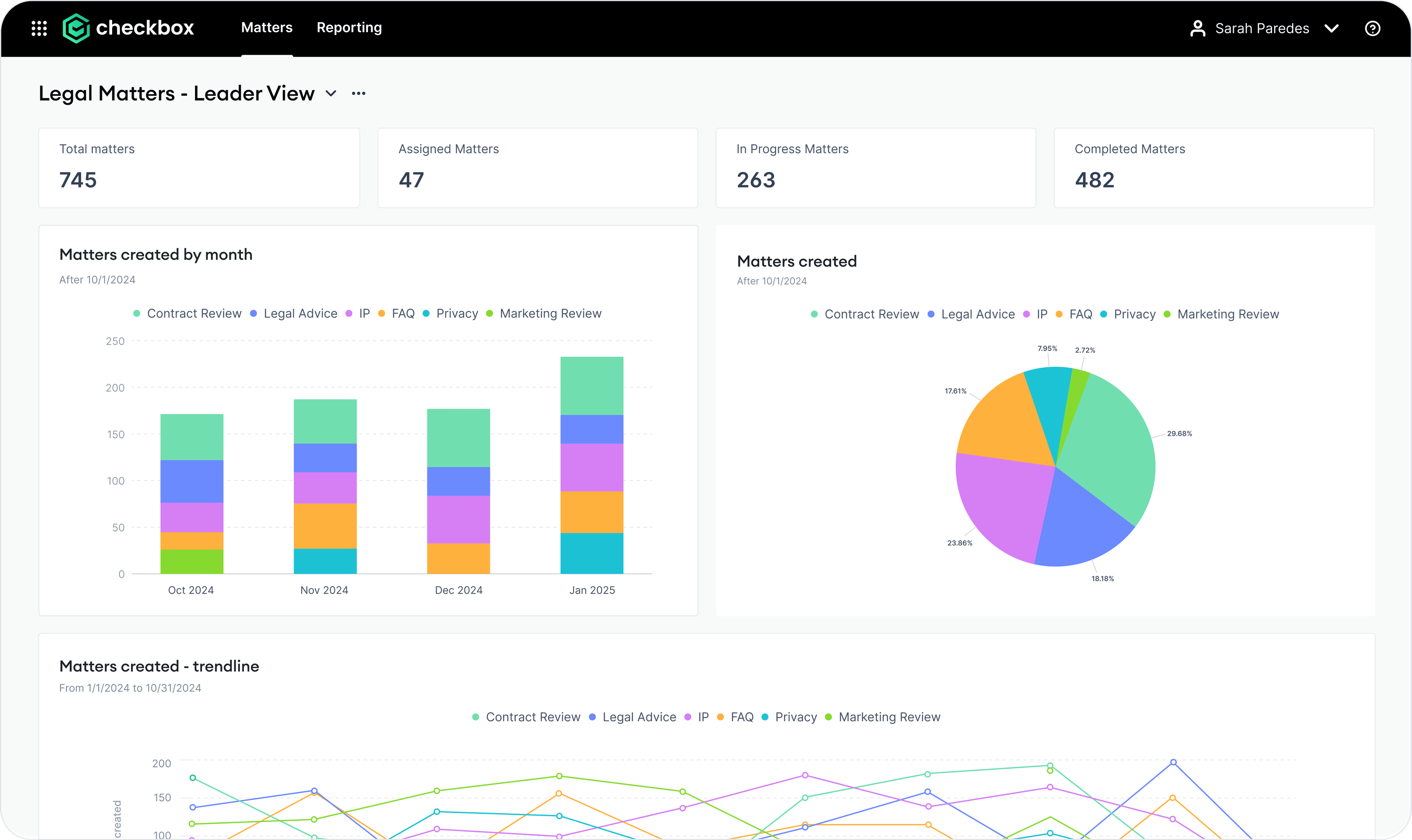
Sign up to our newsletter
Get insightful automation articles, view upcoming webinars and stay up-to-date with Checkbox
Reading time:
[reading time]

Every legal team knows the reputation: the “department of no.”
It’s an unfair label, but one that sticks. When business leaders hear “no,” they often hear resistance. What they don’t see are the tradeoffs, the risks, or the sheer volume of requests that land in legal’s inbox each day.
The reality is that most legal teams want to say yes. They want to be business enablers, but without boundaries or clear processes, “yes” becomes costly. Teams stretch too thin, small issues pile up, and critical work gets delayed.
That’s why learning to say no (and say it well) is a leadership skill. It’s about setting priorities, communicating clearly, and creating systems that make collaboration smoother.
Let’s explore how legal leaders can protect their team’s time while maintaining strong partnerships across the business.
When Does Saying “Yes” Becomes a Problem?
Most in-house legal teams start from a good place: be responsive, be helpful, be a partner. But when “yes” becomes the default answer, things start to break down.
Every “yes” carries a cost: time, attention, and risk. Taken individually, those costs seem small. But, collectively, they drain capacity and make it harder to focus on the matters that actually move the business forward.
Lawyers running on empty because every request feels urgent.
Work piling up in inboxes with no clear prioritization.
Business teams wondering why turnaround times keep slipping.
Ironically, saying “yes” to everything can make it harder to deliver on anything and the legal team becomes reactive instead of strategic.
How To Create Constructive Boundaries
For legal leaders, a well-placed “no” is about direction. It signals priorities, defines ownership, and protects the team’s ability to deliver quality work. The key to communicating this to the business is in how it’s framed.
There’s a big difference between a hard stop and a guided boundary.
- Hard stop: “No, we can’t do that.”
- Guided boundary: “No, but here’s a self-service NDA tool you can use.”
The second version still protects legal risk but gives the business a clear path forward. It turns “no” from a roadblock into a roadmap.
Clear boundaries also build credibility. When legal consistently explains the why behind decisions, whether it’s a policy, a workload limit, or a compliance issue, it shows transparency and earns trust. Over time, those conversations shift the narrative. Legal stops being seen as the department of “no,” and starts being seen as the team that keeps the business on track.
Related Article: Learn more about how legal automation tools help streamline routine legal tasks.
3 Ways to Say “No” Without Damaging Relationships
Saying “no” doesn’t have to create tension. The most effective legal leaders use structure and communication to turn refusals into alignment. Here are three practical ways to do it.
1. Define What Legal Supports & What It Doesn’t
Unclear expectations are often the root of frustration. If business teams don’t know which requests fall under legal’s scope, every unanswered question feels like a delay.
Start by documenting and communicating what the legal function covers and what it doesn’t. Define the types of work that require legal review versus what can be handled by the business. A service framework or intake policy gives everyone the same reference point.
Tools like structured intake systems help make these boundaries visible and repeatable. When every request is logged and routed properly, legal is seen as the function that keeps the business running smoothly.

2. Use Transparency to Build Understanding
“No” lands better when it’s backed by data. Sharing metrics on workload, response times, and risk profiles helps others see that prioritization isn’t arbitrary, it’s grounded in impact. When business leaders understand that reviewing a high-risk contract may delay a routine NDA, they’re more likely to accept trade-offs without frustration.
That kind of transparency builds trust over time. With dashboards and reporting tools in place, teams can show exactly where time is spent and why certain matters take precedence, transforming difficult conversations into informed discussions.

3. Enable Self-Service for Routine Work
Many “nos” stem from bandwidth, not reluctance. Automating repetitive, low-risk work like NDAs, policy questions, or simple approvals, helps legal protect its time while keeping the business running.
When business users can handle standard agreements or minor requests themselves, the legal team can focus on high-value matters without sacrificing oversight. A well-designed self-service system builds confidence on both sides: business users get faster answers, and legal knows appropriate guardrails are in place.

Building a Culture That Respects Boundaries
Boundaries stick when they’re shared, understood, and modeled from the top down.
When legal leaders communicate clearly about priorities and explain why certain work takes precedence, it gives the rest of the team permission to do the same. It turns “no” from a defensive move into a sign of focus. Over time, that consistency builds trust both within the legal team and across the business.
The business also plays a role. When legal operates transparently, it encourages reciprocal behavior. Business stakeholders start to share more context upfront, submit better requests, and plan around realistic timelines. That creates a two-way rhythm: legal is seen as responsive and fair, and the business becomes more disciplined in how it engages legal.
💡Pro Tip: Legal technology reinforces this culture. When every request is captured, triaged, and tracked through a single system, conversations become about priorities and process.
Ultimately, respect for boundaries comes from structure. When it’s clear how legal work flows, who owns what, what gets automated, and how priorities are set, “no” no longer feels like rejection. It feels like alignment.
Key Takeaways
The ability to say “no” without damaging relationships isn’t about being firm or charismatic, it’s about being clear. When priorities, workloads, and responsibilities are transparent, rejection becomes less emotional and more operational. It signals that legal is thinking strategically about where its time adds the most value.
The legal teams that do this best share a few traits. They communicate expectations early, make their decision-making process visible, and build systems that handle the routine work so they can focus on the complex, high-risk, and high-impact matters that truly need their attention.

That structure, whether it’s a clear intake process, a workflow that automates routine approvals, or a dashboard that shows where time is going, is what gives legal the confidence to set boundaries without losing goodwill.
Ready to make saying “no” easier? Book a demo with Checkbox to see how structure and automation help legal teams protect their time and say “yes” more often with AI-powered self-service tools.
Frequently Asked Questions
What is the best way to decline client requests without harming firm relationships?
Offer alternatives instead of a flat refusal. For example, redirect to a self-service resource or suggest a modified timeline. Clients value responsiveness more than blind agreement.
What are some firm policies to support leaders saying no and managing workload?
Policies that define legal scope, turnaround expectations, and escalation paths make “no” consistent and defensible. Workflow automation tools like Checkbox reinforce those boundaries.
How can in-house legal teams avoid being seen as the “department of no”?
By replacing ad-hoc refusals with clear intake processes, transparency, and self-service tools, legal teams shift from blockers to enablers.
What technology helps legal leaders manage requests more effectively?
Legal workflow automation platforms like Checkbox centralize intake, automate low-risk work, and give visibility across all matters.

Checkbox's team comprises of passionate and creative individuals who prioritize quality work. With a strong focus on learning, we drive impactful innovations in the field of no-code.
Book a Demo
See the New Era of Intake, Ticketing and Reporting in Action.

.svg)


